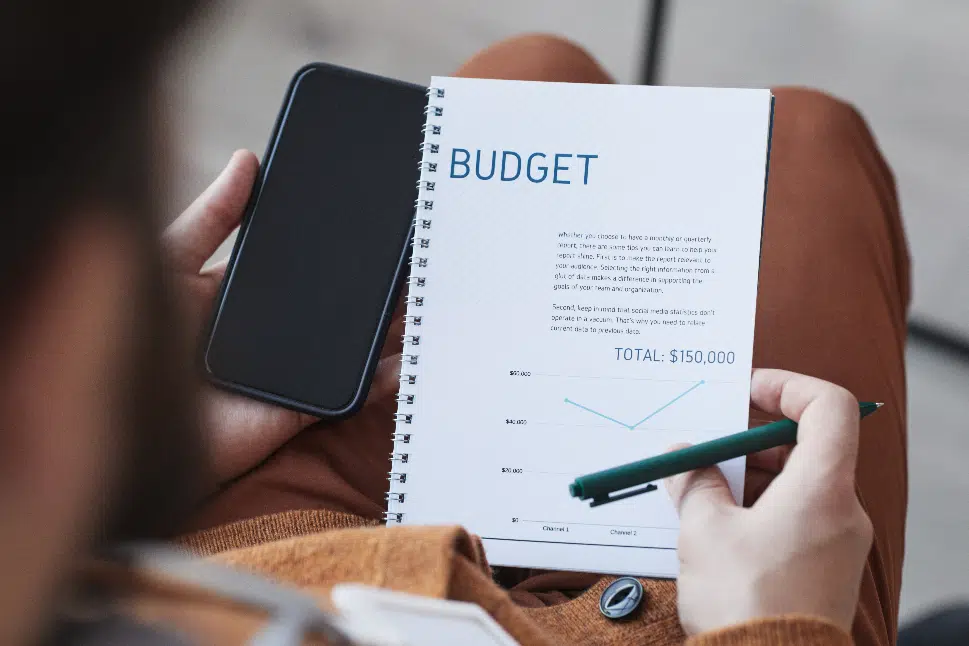One of the most difficult decisions in business is deciding where to focus your cash flow. When it comes to paid ads, this can get even murkier. If you’ve read the first two blogs in our series on paid ads, you will know where to focus your digital marketing and the core elements of a paid ad. But with your real dollars, have you developed a strict budget? Or do your advertising costs ebb and flow with whatever cash remains available? We’ve put together a stress-free budget guide for your paid ads, so you can maximize your budget and get leads that cost less.
Download our FREE Paid Ads Checklist
Understanding the Funnel
The funnel is the marketing process by which your audience becomes a customer. It goes from the first stage–they see an ad campaign–all the way through to making their first purchase. You decide how your brand presents the funnel. But it must start at the wide top and funnel the client down to your services.
It’s important to see the funnel from both perspectives. What are your goals with the funnel? What are your client’s goals?
Your Goals
Top of funnel
The top of funnel is the introduction. At the introduction, people learn about your brand for the first time. Making a good first impression is necessary at this stage. It’s the only way people will learn about what your company does. In the ((first blog)) in this series, we talked a lot about the top of funnel and deciding on advertising platforms.
Middle of funnel
At this stage, you need to engage your potential customers. It’s time for you to demonstrate the reason this audience needs to do business with you. As they have a chance to understand what you offer, you are opening the door for a relationship.
Bottom of funnel
This is the critical point where you are actually getting your audience to shop with you. Until they are ready to buy from you, they are no more than a scroller on Facebook or an email address on your list. At the bottom of funnel, your potential clients have a chance to become actual clients.
Your Customer’s Goals
Top of funnel
At the top of the funnel, your potential customer may not realize that they are missing the thing your product or service will fulfill. Here is your opportunity to show them the gap. In reality, the customer is looking for entertainment of some sort. Your ad just happens to be an interruption to that. Make that interruption worth your money.
Middle of funnel
Now that the customer is aware of the problem they are facing by not having what you offer. At this point, they are discovering that there are solutions to this newfound struggle, and you are the first one to present an option.
Bottom of funnel
At the bottom of funnel, potential customers are actively searching for a solution to their problem. They might be researching your competitors or investing all their time and energy in your website. Either way, this is when they feel the need to look into the resolution for their problem.
Planning Your Strategy
All of this leads to how you plan your strategy. You have to ensure that the stage in the funnel is matched. How can your goals for that stage provide for the customer’s goals at the same stage? How can you align to their needs with your paid ads?
This is why you post your ads on the platforms your target market tends to spend the majority of their time. Don’t waste your ad budget by posting them in the wrong place.
An important element to include in your strategy—and your budget—is testing new and creative ads. You don’t want to keep the same one, single ad for six months and expect people to be excited by it. Be inventive and let your target market see something new. Make an impression. Promote the same thing in a new way. Then, take a look at which ads performed best and analyze the reasons. (Don’t worry, we will look at this more in the fourth post in this series!)
At the end of the day, the best paid ad strategies are all about showing the right offer to the right person.

Planning Your Budget
It’s vital to understand how funnels work when planning your ad budget. Maybe, however, you are at a point where you need to know metrics. For that, there are three things to consider.
From the Beginning
Ensure that you are tracking how to optimize your budget. This means having your goal and your KPIs (key performance indicators) planned out in advance. You need to know what this marketing budget is working toward, so you aren’t left wondering whether or not it was successful.
A good goal to aim for is your ROAS (return on ad spend) to be a ratio of 4:1. That means that for every dollar that you spend, you generate $4 in value.
Take time to do the math. How much money did you spend on your paid ad? And how much money did you make as a result of that ad? Was it at least $4 for every $1 you spent? Did your ad spending acquire leads that enabled you to get sales? Are there areas you need to grow and improve?
Your Budget and the Funnel
You might be wondering where your ad spending goes in relation to the funnel and why that’s important. Some people may think that because the final sale is the most critical step, that’s where they should focus their budget. But no company gets a final sale until the audience knows who they are.
As a rough estimate:
- Top of funnel- 75-80% of your budget
- Middle of funnel- 15-20%
- Bottom funnel- 10%
The majority of your budget will go to the top of funnel. Awareness is the first and most critical step to gaining conversions. From there, the middle and bottom of funnel won’t be as much. The majority of that budget will go toward retargeting campaigns and reminding people to buy the product they are interested in.
Download our FREE Paid Ads Checklist
Letting Your Ads Work for You
As you spend on your ads, be sure to allocate as much of your budget as possible to the ads that are performing well. Keep an eye as you go and don’t be afraid to try something new if things just aren’t working for you.
Ads can be time-consuming and budgeting for them isn’t always fun, but that doesn’t mean you need to stress about it. Your ads should be doing the work for you, gaining new leads and selling products. If you’re struggling, consider working with an agency like Planify who can help.
In the meantime, keep an eye out for the last blog in our paid ads series. We will talk all about analytics and evaluating the performance of your paid ads!

